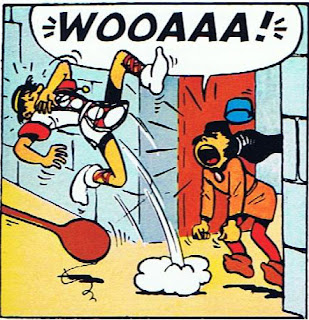A new comics blog, heralding a significant moment in culture:
This is, remarkably, the fourth theatrical feature film featuring the little blue gits.
You probably noticed the previous two (2011's The Smurfs and 2013's The Smurfs 2) which were a combination of live action and CGI and starred Doogie Howser and Apu.
The first was The Smurfs and the Magic Flute, a Belgian cel-animation from 1976.
It's surprisingly good. Really. Maybe because the Smurfs themselves are little more than suporting characters for Johan and Peewit, the real stars.
Who?
I'm glad you asked.
Let me take you back to 1928 and the birth of one Pierre Culliford, who would get the nickname Peyo due to an English cousin who couldn't say his name correctly.
Actually, let's skip ahead to 1952, as that's when our story really starts.
Peyo had been earning a living as a cartoonist for various publications for a few years before getting a big break working at Le Journal de Spirou, a very popular anthology comic in Belgium, thanks to his friend Andre Franquin (a well-respected creator of the day). There he was able to create long-form stories of the adventures of Johan, a character he previously drew in other papers. Influenced by Hal Foster's Prince Valiant, Johan was a medieval page boy, trusted by the knights of his kingdom.
His first adventure is what we are interested in today, but we'll come back to that.
Over time, Johan becomes associated with his best friend, the more dimwitted, comedy relief Peewit and then... on one adventure....
They stumble across a strange, tiny blue creature, three apples high.
In the adventure originally titled La Flute a Six Trous (1958), we first encounter the beings called Schtroumpfs. Which were anglicised to Smurfs later.
They were an immediate hit. Just like Popeye, Shmoos and Snoopy before, you never know when a supporting character will become a merchandising goldmine.
The public demanded more Smurfs. And more Smurfs they got.
The first Smurf spin-off strip appeared a year later and the full story was published as Les Schtroumpfs Noirs in 1963.
The story concerns a Smurf being bitten by an insect and immediately turning black, angry and violent. On the English translation they changed the colour to purple to avoid any unintended racial connotations.
The original smurf bites the first smurf he sees who also becomes a purple smurf, just as angry and violent. Soon the biting "virus" spreads throughout Smurfland. Long story short, Papa Smurf finds an antidote and cures them all, but, from a 21st century perspective we can all see what this is.
A zombie outbreak.
Almost ten years before George Romero invents the genre with Night of the Living Dead (a movie that deliberately plays with racial tensions and the civil rights movement too).
And a merchandising phenomenon was born!
The solid plastic figurines became the must-have toy across Europe. By the late 1970s in Britain they were mascots for a chain of petrol stations...
...and had a regular original comic strip in Look-In Magazine.
And then there's the records...
Father Abraham in Smurfland was an album released in 1978 and was a massive hit across Europe. Particularly the single Smurf Song which was inescapable that year. If you want be slightly disturbed watch this video:
Or if you'd prefer to be REALLY disturbed watch Legs and Co perform a dance to it on Top of the Pops.
Good to know their choreographer also misheard "small keyhole" as "smoky hole", just like I did when I first heard it.
Such a massive hit that "Christmas in Smurfland" was inevitable.
Not an enormous amount of time spent on that design.
In 1981 American animation powerhouse Hanna Barbera produced a TV series called The Smurfs that ran for 9 seasons, cementing the little blue gits in the minds of entire generations worldwide.
So now everyone knows what Smurfs are but no-one remembers Johan.
So let's celebrate Johan by taking a look at his first proper adventure. The above-mentioned Le Chaitemant de Basenhau (The Punishment of Basenhau).
We begin our story in our undisclosed European country in a non-specific year in the middle ages. A jousting contest is taking place.
Johan is friends with the King's champion who needs his help.
Whilst going for the lance, Johan stumbles across the Count's rival attempting to sabotage his lance.
Told you.
The match is cancelled and the challenger thrown out.
This rival baron does not take too kindly to his plan being thwarted. And plans revenge. A plan to take over the kingdom and seat himself on the iron throne.
A spy is sent to the kingdom disguised as a travelling minstrel. Johan is immediately suspicious and accosts him in the style of Tintin's dog Snowy.
The troubadour runs for it and is tackled by our hero.
Then, when our heroes demand information, the baddy refuses to co-operate.
He is introduced to the king's executioner.
No seriously. he's referred to as the executioner in the text.
And this is where things get a bit weird...
See this story was originally published in chapter form in Spirou, half a page at a time (just like Tintin, Asterix, Lucky Luke, Blake and Mortimer et al.) and when the next chapter was submitted fellow cartoonist Franquin asked the editors what the French censors would say about the "torture scene". This gave the editors cold feet so the following scene was not published until 2015.
So our heroes (the GOOD guys) leave the baddy in the hands of the executioner to torture as he sees fit.
Oh yeah! We're talking waterboarding!
Also known as extraordinary renditioning.
Or enhanced interrogation.
A reminder: these are the good guys in our story.
Time to remind you this is essentially a humour strip.
Ha! You see, he couldn't be broken with real-world torture techniques but he hates being tickled!
IT'S A JOKE!
So the weird thing is that that one page was declared unpublishable so readers at the time (and indeed in future republishings) skipped from the introduction of the executioner to this:
Which makes sense as a joke (we see a torture chamber: cut to man being tickled). However the distended belly of the troubadour is not referred to. Even as he spills his (metaphorical) guts.
So Johan makes him write a message back to our baddy feeding him false information.
And then... Ah, who cares?
Long story short, the good guys win.
It's late and I'm tired.
Smurfs: more to them than you thought.



































A few Johan and Peewit stories were adapted earlyish on in the Hanna-Barbara series, so perhaps not *completely* forgotten
ReplyDelete